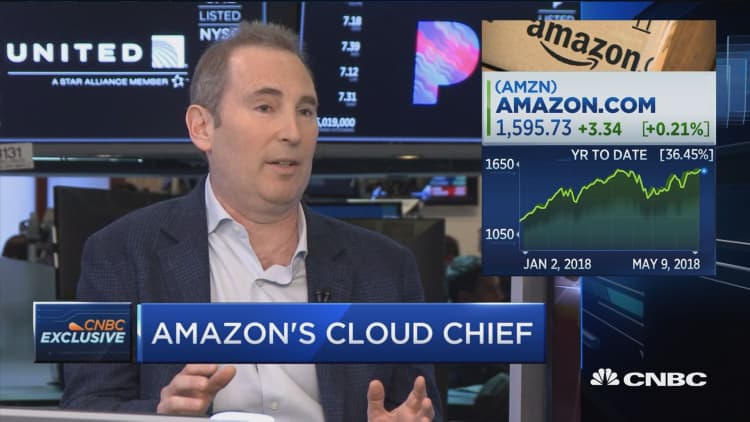Amazon's cloud business is now releasing numbers that show something important about its customer base: loyalty.
Amazon disclosed in its latest quarterly report that it had $12.4 billion in backlog revenue for Amazon Web Services. The balance represents the total value of signed contracts that didn't get reported as revenue because the agreements run for multiple years.
On average, the remaining life on those contracts is 3.2 years, which means Amazon has over $12 billion of sales that will turn into revenue over that stretch. The contracts have different terms, so it's unclear exactly when the revenue will be recognized.
The new disclosure is the latest sign of AWS' maturity as a software business, expanding from a pay-as-you-go service for smaller startups to a multi-year contract model that targets enterprise customers. The increase in backlog revenue gives investors a clearer sense of the strength of the business.
"This is further confirmation to the notion that Amazon's AWS business has great scale and is becoming increasingly predictable with longer-term, enterprise customers," Tom Roderick, an analyst Stifel Nicolaus, told CNBC.
Microsoft reported contracted revenue of $61 billion as of the end of March and expects to recognize 60 percent of that over the next 12 months. Salesforce said in February that it has $13.3 billion of business that's contracted but not billed.
'Sticky' service
Roderick said AWS' numbers suggest that it's become a "sticky" service that locks in customers, a model big businesses prefer because it comes with volume discounts.
Large enterprise customers are nothing new to AWS, which has long served companies like Netflix and Airbnb and has a giant contract with the CIA. But now it's becoming more common for big companies to move their entire computing infrastructure to the public cloud, with AWS leading that market.
"It used to be if you were an enterprise customer, you only used AWS for 'burst' or extra capacity, so pay-as-you-go totally made sense," said Tien Tzuo, CEO of Zuora, a provider of cloud software that helps businesses manage their subscription revenue. "Now people are defaulting any computing to be in the public cloud, so they can estimate their computing needs in advance."
AWS reported revenue growth of 49 percent in the first quarter to $5.4 billion. So far this year, companies including Shutterfly and GoDaddy announced they're going "all-in" on AWS, while Oath and Comcast (owner of NBC, the parent of CNBC) chose it as their "preferred partner."

Matt McIlwain, a partner at Seattle-based Madrona Ventures, said the growth in backlog revenue is partly driven by aggressive discounts. AWS offers Reserved Instances, a one to three-year prepaid option on computing resources that comes with hefty price cuts. Its enterprise discount program for larger customers has also been gaining traction of late.
Additionally, the company has been offering more subscription-friendly products like cloud data warehouse and database services, McIwain said.
"It's really an 'and' equation, where they're adding more things to their very large base of existing revenue," he said.
Based on the new disclosure, an average of $4 billion in backlog revenue will convert to sales every year, which accounts for less than 20 percent of AWS' projected $22 billion revenue run rate for 2018.
That means the majority of its revenue comes from shorter commitments, and AWS has to find ways to get those customers to spend more every year, said Prasadh Cadambi, a partner at KPMG, who wrote a report on this topic.
"It suggests that most of the contracts are short-term or with smaller companies, versus longer duration, committed contracts with enterprise customers," Cadambi said. Every year, "they still have to book a lot of deals."
Incomplete number
Tzuo said AWS' metric is incomplete because it doesn't tell investors how many customers are renewing after their contracts expire or how much they're increasing their spending. Most cloud companies disclose additional information, like renewal rates and net expansion rates.
"At the end of the day, it's not about the backlog," Tzuo said. "It's about how much revenue is recurring and its retention power."
Still, Tzuo said AWS likely has high retention because of its dominance in the market over competitors like Microsoft and Google. And now we know it has a huge base to tap as it tries to get customers to stick around for many more years.
"AWS has already spent money acquiring $12.4 billion of revenue," Tzuo said. "Wouldn't we all love to wake up with $12.4 billion, even if we get it over time?"


